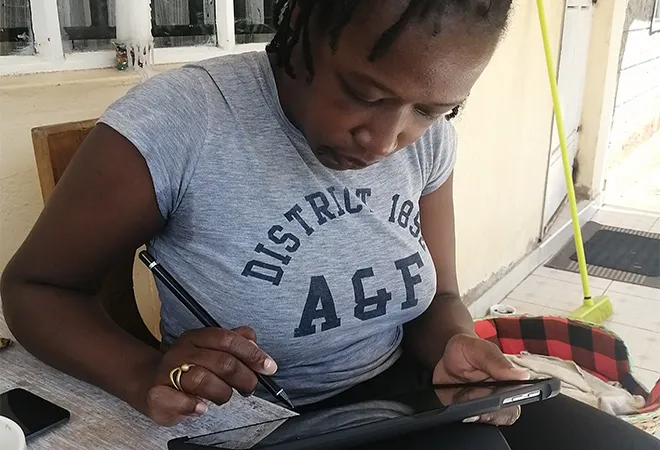-
CENTRES
Progammes & Centres
Location
2020 has seen the rapid uptake of technology in both the formal and informal sectors with many formal employers adapting strategies that have allowed people to work from home.

This article is part of the series — Africa in 2021.
2020 will be remembered as a year of great upheaval for countries all around the world, including Kenya. The sudden and impacting global spread of the novel coronavirus led to the institution of various restrictions on the movement of people, which will have reverberating effects for years to come. The sudden cessation of and limitation in mobility brought to the surface existing socio-cultural, economic, health and safety issues that civil society, non-governmental organisations, and movements had been pushing policy and lived reality shifts for. A national dusk to dawn curfew and restricted inter-county movement, which have now been somewhat relaxed, continue to have a dampening effect on the economy, as well as the social, cultural and health rights of its inhabitants. The World Bank has found that women, youth and refugees in particular are the most affected by the soaring unemployment rate and the slowed down industrial activity in the country. Historically, women have borne the brunt of various structural and intimate violations that limit our ability to contribute equally and access equal opportunities to lessen the burden of poverty in the country.
The economy, which depends on the movement of people and primarily agricultural goods within the country, and the movement of tourists into and out of Kenya, has suffered greatly under these emergency measures. This measure was seen as extreme, and continues to be poorly enforced by an overzealous and a historically unruly police force. The government of Kenya said that these extreme measures were necessary in order to slow the transmission of the virus, in a country with a heavily incapacitated healthcare system. An assessment of Kenya’s hospital capacity to accommodate a surge in COVID-19 cases found that Kenya has a shortage of critical care resources including and especially oxygen, as well as health care workers and the healthcare facilities necessary for critical care.
On the technology front, 2020 has seen the rapid uptake of technology in both the formal and informal sectors with many formal employers adapting strategies that have allowed people to work from home. Some informal sector workers have also moved aspects of their businesses online, a market shift that has been enabled by a robust mobile-money infrastructure and culture and an internet penetration of just over 40 percent. These developments are, however, dominated by urban and peri-urban realities, with rural and semi-rural areas being slower to adapt to more digitised models of commerce due to limited access to the necessary infrastructure.
Given the consistently shifting context under an evolving COVID-19 reality, we can anticipate various trends to continue in 2021, in particular for women in Kenya. Restricted movement is likely to continue in 2021 and beyond. Women entrepreneurs in urban areas have had to adapt their businesses to more online platforms and applications available on smart mobile handsets. Kenya was already experiencing a jump in the market absorption of e-commerce, with the COVID-19 crisis speeding this up. Projections showed that by 2020, the e-commerce market would increase by 16 percent and reach just over 26 percent by 2025. For women in urban areas and with access to smart phones, Instagram and other social media sites such as Facebook and Twitter have become digital marketplaces, where goods and services are exchanged. Social media has been a popular site for the purchase of clothes and other domestic services, but has since changed in 2020 with more basic requirements such as food being sold online. This digitally facilitated connection between buyers and sellers will likely continue in 2021 and beyond.
What is worth mentioning on the society and culture front is how social media has been and will continue to be an important influence, not just on popular culture and society, but also on policy, governance and citizenship issues. 2021 will see the creation of more digital content, especially podcasts and video blogs by women highlighting social justice concerns, as well as edutainment. A 2019 audience survey on the state of podcasting in Kenya showed that over 50 percent of the survey respondents were women. Podcasts have become a popular way to get a message across and create alternative content that disrupts stereotypes about women and womanhood. They are also fun and reflective spaces for people to tune into at a time that is convenient for them. There are also quite a few podcasts that focus on gender and sexuality, health and popular culture in Kenya. Popular platforms for streaming podcasts are Soundcloud, Spotify, Apple Podcasts and Buzzsprout. For a better sense of the variety of podcasts emerging in Kenya, TechWeez populated a list of podcasts worth checking out.
In addition to the increase in podcasting in 2021, we will also see the sprouting of more video blogs online, or vlogs, with young, urban women dominating the space. YouTube has been the dominant space of choice for many vloggers. Vlogging has become a quick and convenient way for people to upload content and share ideas or sell a good, service or concept. Initially popularised by the ‘influencer’ phenomenon, vlogging has now evolved to include a wide variety of content and creators. Women still dominate the space, and other applications, such as TikTok and IGTV that allow the uploading of short and longform videos create additional platforms that young people and, in particular women with access to a smart phone and a good internet connection, use to create content. 2021 will see the continued domination of young women in the space, with more content creators moving away from the longer video formats on YouTube to the shorter and faster TikTok style.
The views expressed above belong to the author(s). ORF research and analyses now available on Telegram! Click here to access our curated content — blogs, longforms and interviews.

Sheena Magenya works for The Association for progressive Communications (APC) as the Coordinator of the All Women Count-take Back The Tech! (AWC-TBTT!) Project. The views ...
Read More +